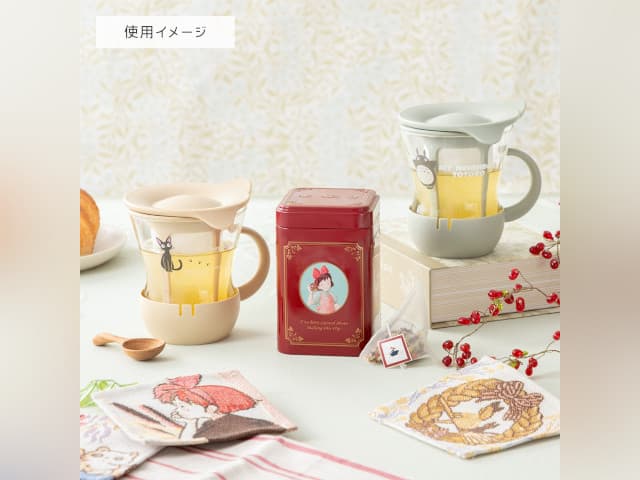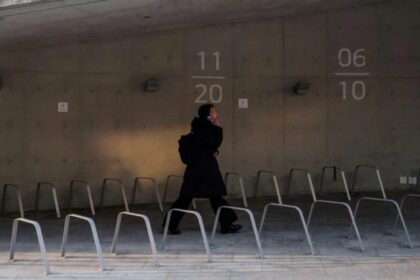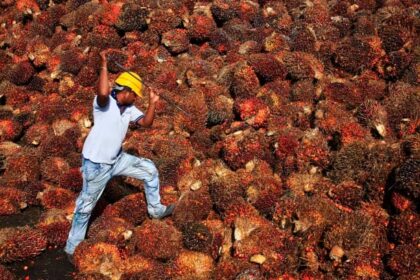A cozy new Ghibli tea ritual arrives in Japan
Studio Ghibli has brewed a new way to enjoy tea time. The Ghibli specialty chain Donguri Kyowakoku has introduced a red tea tin and two glass mugs that pull beloved details from Kiki’s Delivery Service and My Neighbor Totoro into a practical set for everyday sipping. The tea tin, called Kiki’s Departure Original Tea Blend, comes filled with eight bags of a Ceylon and chamomile blend with a soft fruity aroma. The companion mugs are made by Hario, the Japanese glass maker known for heat resistant glassware, and include a removable strainer and lid to brew a single cup with little fuss.
- A cozy new Ghibli tea ritual arrives in Japan
- What comes in the Kiki tea tin
- How the Hario glass mugs work
- Prices and where to buy
- Why tea culture fits Ghibli stories
- Design references fans will spot
- Part of a growing Ghibli home line
- How to get the most out of a one cup brew
- Collectibility, care, and reuse
- At a Glance
Design plays a starring role. The tea tin mirrors the one Kiki packs when she leaves home in the 1989 film, complete with a blue circle portrait of Kiki and tiny objects from her room printed around the sides. Jiji appears on one panel, the lid carries a witch on a broom with sun and moon symbols, and the tags on each tea bag continue the witch motif. The mugs lean into character charm as well. One features Jiji surrounded by a bread wreath that recalls the bakery that welcomes Kiki. The other centers on Totoro and the soot sprites, an instant comfort pairing for fans who like to watch their tea deepen in color through clear glass.
What comes in the Kiki tea tin
The tin itself aims to be both collectible and useful. Once the eight bags are gone, the sturdy red canister becomes a tidy place to store keepsakes, tea refills, or pantry items. The layout around the tin nods to Kiki’s room. Look closely and you will spot her stuffed toys, her knapsack, and the red radio that belongs to her father. These small references carry the feeling of a room packed with memories, captured in a container you can hold in one hand.
Inside are eight individually tagged bags of a Ceylon and chamomile blend. Ceylon black tea tends to be brisk and fragrant, while chamomile adds apple like sweetness and a gentle calming note. Steeped together, they create a fruit forward aroma with a soft finish that suits afternoon breaks and evening wind downs. The tea tags are printed with a witch silhouette that ties back to Kiki’s hometown, and the blend name, Kiki’s Departure, echoes the film’s first act in which a determined apprentice sets out to find her place.
How the Hario glass mugs work
The mugs are designed for a personal brew without any extra equipment. Each set includes a clear glass cup, a fine metal strainer that drops into the rim, and a lid. The lid helps keep heat in while the tea steeps, then doubles as a stand for the strainer after you lift it out. The glass shows the color of the tea as it develops, which is satisfying for black tea drinkers and herbal fans alike. Once the lid and strainer are removed, the glass cup can go in a microwave for reheating. That convenience fits home offices and compact kitchens where space is tight.
Kiki one cup mug details
The Kiki’s Delivery Service version features Jiji framed by a bread wreath. That motif recalls the bread sign used for Kiki’s courier business in the film. It adds a gentle nod to community, work, and daily care that runs through Kiki’s story. The cup height is about 4.2 inches and the capacity is about 200 milliliters, which suits a focused cup of black tea or an herbal infusion. The glass is heat resistant, and the removable strainer makes it simple to use loose leaf or to hold a bag below the waterline for a stronger cup. Rinse by hand to protect the printed art from harsh scrubbing, and avoid sudden temperature shocks that stress any glass vessel.
Totoro and soot sprite mug details
The second mug highlights Totoro with the soot sprites. It has the same strainer and lid setup and the same clear glass build, so it matches the Kiki mug as a pair. Fans who lean toward herbal blends can enjoy watching chamomile or fruit infusions shift from pale gold to rich amber. For collectors, display value matters. The character artwork appears on multiple sides, which gives a friendly face no matter how you set the mug on a shelf.
Prices and where to buy
The Kiki tea tin is priced at 3,080 yen (about 20 to 21 US dollars at recent exchange ranges). Each Hario glass mug set costs 2,860 yen (about 18 to 19 US dollars). Both the tea and the mugs are available through Donguri Kyowakoku stores across Japan and the chain’s official online shop. The rollout aligns with cooler weather, a season when Ghibli often refreshes its hot drink lineup.
Shoppers outside Japan may find that the official online shop ships only within Japan. Many fans use domestic delivery to a friend or a forwarding service, although that adds fees and time. Another route is to check authorized retailers in your region that carry licensed Ghibli goods. Prices can vary outside Japan because of import costs, but licensed items will carry Studio Ghibli and Benelic markings on packaging and paperwork. That authenticity check helps avoid unlicensed lookalikes that sometimes surface on large marketplaces.
Why tea culture fits Ghibli stories
Tea is more than a drink in Ghibli films. Everyday rituals, gentle meals, and shared breaks are core to the studio’s storytelling. Viewers often recall simple scenes that carry a feeling of care. In Ponyo, a parent fixes honey tea and instant noodles after a stormy drive. In My Neighbor Totoro, Satsuki and Mei settle into a new home with small daily tasks that warm a table. Kiki herself learns work rhythms in a city bakery and rests with a cup when the day slows. These moments create small pauses that make the worlds feel lived in. A home goods release that centers on tea fits that spirit and brings a film detail into a daily habit.
There is also a practical design through line. Clear glass makes color and steam part of the experience, and a compact strainer reduces equipment to a single cup. That simplicity matches the calm craft that fans expect from goods tied to these films.
Design references fans will spot
The tin has a tight set of callbacks. A round blue frame around Kiki echoes a bedroom scene, and the surrounding objects read like a shelf scan from her room. Jiji stands out on one side panel with a curious look that fans will recognize. On top, the witch on a broom floats between sun and moon motifs, a nod to the day Kiki flies off to start her independent year. Even the tea tags are part of the story, since the witch silhouette links to Kokiri’s household back in Kiki’s hometown.
The mugs translate symbols into everyday charm. The bread wreath nods to Kiki’s work sign and the theme of care and craft. The Totoro art bundles forest spirit warmth with the cheerful soot sprites seen in both Totoro and Spirited Away. These are gentle signals that tune a tea break to a favorite film without turning the cup into a busy collage.
Part of a growing Ghibli home line
Donguri Kyowakoku has built a strong catalog of tea friendly goods in 2025. Earlier in the year, a Kiki Bouquet Series brought a glass teapot with Jiji on the lid, plus a matching teacup and saucer set in purple and yellow tones. The teapot sat around the mid 5,000 yen range, while the cup and saucer followed in the 4,000 yen range. Those releases focused on floral motifs that connect to Kiki’s mother’s greenhouse, with details like a Miss Witch emblem and sprigs of lavender.
Seasonal lines remain popular. During cherry blossom season, the shop restocked My Neighbor Totoro ceramics crafted with Mino ware techniques from Gifu Prefecture. That collection included a teapot, Japanese style tea cups, a rice bowl that doubled as an ice cream bowl, and plates sized for small sweets, with most pieces in the 2,200 to 2,970 yen range and the teapot around 6,270 yen. The Mino ware link matters because it ties licensed character goods to regional craft, a combination that appeals to collectors who value both art and material quality.
Accessory items round out the table. Wool coasters shaped like Totoro, Jiji, soot sprites, and Calcifer offered a soft landing for hot mugs during winter. Cloth coaster sets with gobelin weave returned for autumn, with sets covering Totoro, Kiki, and Howl’s Moving Castle at 2,200 yen for a bundle of four. Drinkware has also stretched into travel use, with stainless vacuum mugs featuring Totoro, Kiki, Porco Rosso, and No Face released to keep drinks hot through cold commutes. Off the table, diorama hourglass pieces with Totoro and Jiji show that the brand continues to explore warm, quiet scenes for desks and shelves.
How to get the most out of a one cup brew
A single cup setup performs best with a few simple steps. Pre warm the empty mug with hot water for a minute, then pour it out. Place the strainer in the rim and add tea. For the Kiki blend, 200 milliliters of water just off the boil works well, around 95 to 100 degrees Celsius. Pour slowly over the tea to wet all leaves or the bag. Cover with the lid and steep for three to four minutes if you prefer a brisk Ceylon forward cup, or five to six minutes to draw more chamomile. Lift the strainer onto the upturned lid to avoid drips. Sweeten or add milk according to taste. The clear glass will make the color change easy to watch, which helps you tune your timing over a few sessions.
The same method works for loose leaf or bagged herbal blends. For delicate green teas, reduce water temperature to around 70 to 80 degrees Celsius to avoid bitterness. Avoid pouring boiling water into a cold cup. A brief pre warm reduces thermal stress on the glass and keeps the final cup hotter for longer.
Collectibility, care, and reuse
For long term enjoyment, hand wash the cups and lids to protect the printed art. Most character print techniques last longer when they avoid repeated cycles in strong dishwashers. Avoid metal scouring pads. The metal strainer can be rinsed under running water and patted dry. Glass can stain after many black tea sessions, which lifts with a brief soak in a mild baking soda solution.
The Kiki tin is a natural keepsake box. Its size fits tea sachets, sewing notions, small stationery, or a stack of favorite photos. Fans who mix and match older Ghibli tableware might recall fine porcelain cups produced in past years by makers like Noritake. Those bone china designs have a different weight and finish compared to Hario glass, so a shelf that combines both shows the range of materials in the Ghibli catalog.
If you shop beyond official stores, look for the Studio Ghibli approval seal and Benelic branding on boxes or tags. Artwork that looks over saturated, misaligned, or printed on low grade materials can be a warning sign. Authorized retailers often list capacities, dimensions, and maker names, such as Hario for glass or Mino ware for ceramics. Those details provide a reliable trail of quality.
At a Glance
- New Kiki’s Departure Original Tea Blend tin includes eight bags of Ceylon and chamomile tea with a fruity, gentle profile
- Two clear glass mugs by Hario feature Jiji with a bread wreath and Totoro with soot sprites, each with a removable strainer and lid
- Tea tin priced at 3,080 yen, mugs at 2,860 yen each, available at Donguri Kyowakoku stores and the official online shop in Japan
- Hario mugs hold about 200 milliliters and stand about 4.2 inches high, microwave safe once lid and strainer are removed
- Tin design pulls from Kiki’s bedroom and departure scene, with Jiji on the side and a witch on a broom on the lid
- Release fits a broader Ghibli home lineup that includes Kiki Bouquet Series teaware, Totoro Mino ware ceramics, and seasonal coaster sets
- Official online shop focuses on domestic shipping; overseas fans can look for licensed retailers that carry Studio Ghibli goods
- Care tips: hand wash to protect printed art, pre warm glass before pouring hot water, and reuse the tin for storage after the tea is gone












